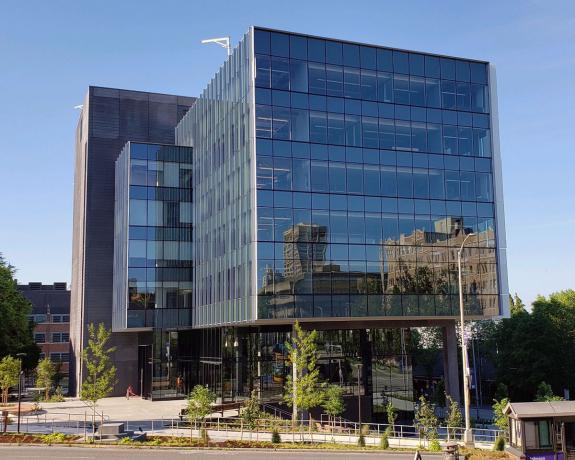Building a landmark during a pandemic

It’s been said, “If you build it, they will come.”
But what if you’re in the middle of a pandemic? How do construction projects continue safely? What if you’re constructing a building for some of the very people who are fighting that pandemic?
It wasn’t business as usual, but not even COVID-19 prevented UW Facilities and its partners from the safe construction and completion of the Hans Rosling Center for Population Health. The $230 million project, which was recently completed on the university’s Seattle campus, houses the Department of Global Health, the Institute for Health Metrics and Evaluation, portions of the School of Public Health, and the UW’s Population Health Initiative.
The 300,000-square-foot center is named for Hans Rosling, an innovative Swedish physician who died in 2017 and whose global health perspective embodies the mission of the Center.
The building is an equally progressive architectural jewel located on the west side of campus. The aim of the Center is to encourage multidisciplinary work in population health across the UW: A place that provides for a collaborative focus on critical issues including poverty, equity, health-care access, climate change and government policy.
Building any new facility at the University is a challenge, of course, but the job site safety protocols required by the coronavirus dictated a different construction cadence than that of past campus projects. These protocols came into effect in March following Governor Inslee’s order regarding COVID-19 and were followed through until construction was completed on July 8.
Construction manager Mark Sweeters of UW Facilities’ Project Delivery Group says the most challenging aspect of the project was getting crews who usually work in close proximity to each other, especially with heavy materials, to rethink how they could complete the work while six feet apart.
“We asked these kinds of crews to submit a work plan in writing, which we would review and comment on,” he says. “There was actually little resistance to these efforts and the crews themselves came up with some good engineering-type solutions allowing them to complete their work while socially distanced.”
“The end result,” he says, “was that we had no evidence of COVID-19 being transmitted on the job site, even though we had six separate individuals test positive.”
Required work plans answered questions such as: What is the number of workers performing the work? What personal protective equipment will workers utilize to mitigate hazards?
Once construction is finished, the next stage for new buildings is transition to occupancy. During this phase, furnishings and occupants are moved into the building, but of course that was different this year as well.
“The transition to occupancy phase began July 8 and was completed Sept. 8,” says senior project manager Jeannie Natta, also of UWF’s Project Delivery Group.
UW employees arranged to return to campus with their departments to pack their belongings prior to the move. Caution was taken to ensure there were not more people in the building than could be managed with social distancing. The moving crew moved their crates into the Hans Rosling Center and then employees came to the center at scheduled times to unpack the crates.
Additionally, every person entering the building during the transition to occupancy was required to go through the designated wellness check station, where they were screened for COVID-19 symptoms. UW employees are also required to follow departmental attestation procedures, such as Workday reporting.
Cloth face masks were and are required inside the building per state guidelines; only one person was allowed in the elevator at any time during project completion and daily pre-screening wellness questions were administered to all contractors and vendors entering the work site. And any University department or unit that learned of a suspect or confirmed COVID-19 case among an employee, contractor or vendor was required to notify UW Employee Health & Safety.
Most of the building’s would-be occupants, including IHME, DGH, and SPH are working remotely until at least April 2021 due to COVID-19 preventions.
“Currently, the building is managed by the occupant groups,” says Natta. “Each group has a safety plan in place for employees. As is true for the rest of the UW, most employees are working from home unless they have reason to be on campus to complete their work.”
Dana Panteleeff, finance and administration director for the Department of Global Health, says that staff had a chance to unpack but returned to telecommuting.
“It’s a beautiful space and we look forward to when we can occupy as planned,” she says.
When, exactly that happens, will depend on advances in identifying a safe vaccine and other novel coronavirus safety metrics. In the meantime, future building residents – and everyone else – can keep a live, bird’s eye view on the center, plus look at historical photos from throughout the construction, or take a virtual tour inside the building.
The Hans Rosling Center for Population Health was made possible by a $210 million gift from the Bill & Melinda Gates Foundation in October 2016, $15 million in earmarked funding from the Washington state legislature, and $5 million from the University.





